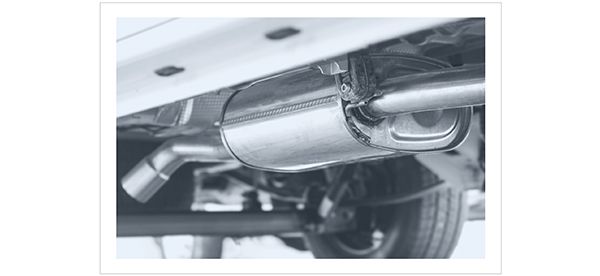"When a vehicle comes in to have the catalytic converter replaced, it almost always goes out with an anti-theft device, too."
Think of a catalytic converter as a very special kind of filter for your car’s exhaust system that reduces harmful emissions. It’s bolted to the underside of every gas-powered car, and it’s vulnerable to thieves because it contains metals more precious than gold. The metals convert harmful exhaust into oxygen, nitrogen, and other less harmful gasses. Catalytic converter thefts have been rising, and the devices are expensive to replace. But a few simple steps might help you protect your car.
A few key facts about catalytic converter theft and how you can help protect your car:
- Thieves target catalytic converters because they contain precious metals.
- Catalytic converters are vulnerable because they’re quick and easy to steal.
- Catalytic converters are expensive to replace.
- You can help protect your car against catalytic converter theft by etching the license plate number on it, parking in well-lit areas and installing an anti-theft device.
Three ways to protect against catalytic converter theft
1) Etch your license plate number onto your catalytic converter.
This makes the part identifiable to law enforcement. The idea is that a thief who sees the etching moves on to an easier target. Police in some communities have joined with local repair shops to sponsor etching events.
2) Park in well-lit areas.
Scott Jones, manager of Chapel Hill Tire, an auto service center in North Carolina, says most of the theft cases that pass through his shop occur in residential lots where cars are parked overnight. If you have to leave your car outside, the National Insurance Criminal Bureau (NICB) recommends parking in a well-lit area and making sure to set your vehicle alarm. Installing a bright motion sensor light may also dissuade potential thieves.
3) Install an anti-theft device.
Etching and careful parking might make your catalytic converter less attractive to thieves, but these preventive maneuvers don’t protect the part itself. Jones says an anti-theft device can help. His shop installs one by bolting a metal shield to the vehicle frame to cover the catalytic converter, which costs about $350, including installation. Other designs resemble a cage or armor plating.
“You can buy one online for about $150 and install it yourself,” says Jones. Installation involves drilling holes in the frame and attaching the device with bolts and fasteners. “The hard part is finding enough space under the car to do this. In most cases, you’re going to need a vehicle lift, which is why people come to us.”

It’s more valuable than gold
It’s not what a catalytic converter does that makes it a target for theft but what’s inside. Catalytic converters contain platinum, palladium and rhodium — precious metals more valuable than gold. (As of May 2021, rhodium was valued at $27,900 per ounce, palladium at $2,896 per ounce and platinum at $1,227 per ounce.) Their value has escalated in recent years as automakers use more precious metals in catalytic converters to further reduce emissions.
In his region, a metal recycler might pay up to $800 for a hybrid car’s catalytic converter, says Jones. Typically, recyclers pay $50 to $250 per catalytic converter, according to NICB.
Car types targeted for catalytic converter theft
The catalytic converters used in low-emission vehicles like hybrids bring the most money because they contain more of the expensive metals. Top-selling hybrids and hybrid models that don’t have a matching all-gas equivalent may be most vulnerable because they’re easier to identify. Thieves may also target trucks and SUVs because the higher ground clearance allows for easier access to the catalytic converter.
“Thieves know exactly what they’re getting in certain models, and those are the ones we see most often with missing catalytic converters,” says Jones. He points out that all-electric vehicles (EVs) are the only ones safe from thieves because they produce no emissions and don’t need a catalytic converter.
Easy to steal, expensive to replace
Thefts are fast and simple, Jones says. The thief slides under the car and removes two or three bolts, or cuts out the catalytic converter with a reciprocating saw. “The sawing is noisy, but it’s over in a couple minutes and the part just falls out,” he says.
The cost to replace a catalytic converter reflects the value of its components. Jones says the replacements performed by his shop range from $2,000 and $2,500, including labor.
Theft on the rise
The National Insurance Crime Bureau reports that the average number of monthly thefts jumped from 282 in 2019 to 1,203 in 2020. In December 2020 alone, 2,347 catalytic converter thefts were reported to U.S. auto insurers, according to NICB data. Jones says his shop has replaced more catalytic converters due to theft in the first four months of 2021 than in all of 2020.
Top 5 states for catalytic convert theft
1. California
2. Texas
3. Minnesota
4. North Carolina
5. Illinois
Source: NICB
Written by
John Diether
The information contained in this page is provided for general informational purposes only. The information is provided by Farmers and while we endeavor to keep the information up to date and correct, we make no representations or warranties of any kind, express or implied, about the completeness, accuracy, reliability, suitability or availability with respect to this article or the information, products, services or related graphics, if any, contained in this article for any purpose. The information is not meant as professional or expert advice, and any reliance you place on such information is therefore strictly at your own risk.
Related articles



